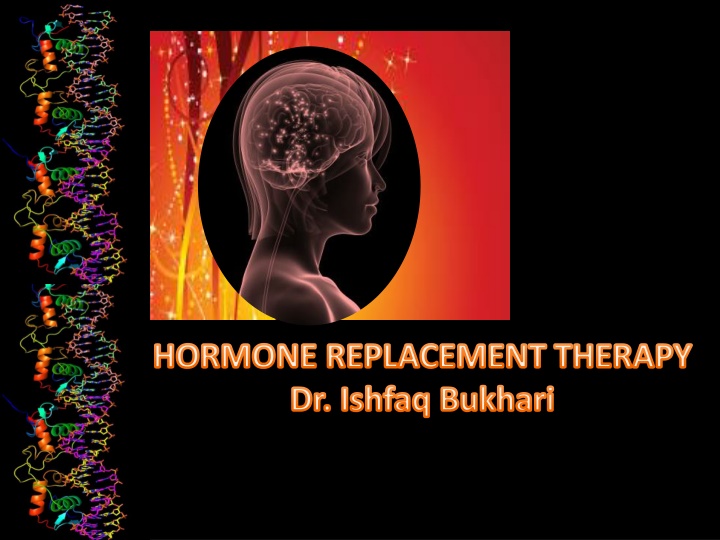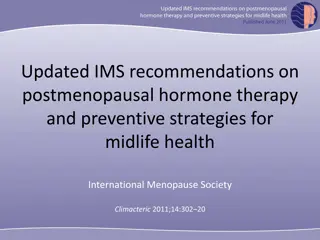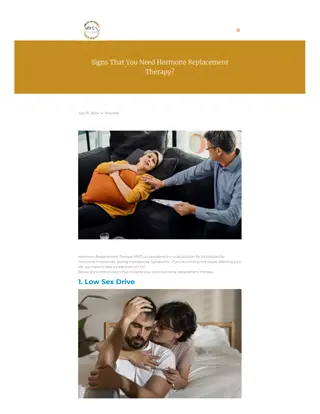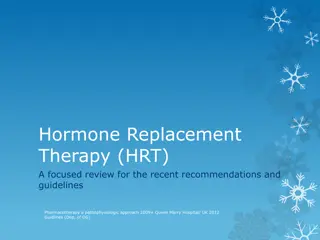
Hormone Replacement Therapy: Recognizing Symptoms and Consequences
Understand the importance of Hormone Replacement Therapy (HRT) in alleviating menopausal symptoms. Learn about the classification, mechanism of action, indications, preparations, side effects, and contraindications of drugs used in HRT to support women through peri- and postmenopause.
Download Presentation

Please find below an Image/Link to download the presentation.
The content on the website is provided AS IS for your information and personal use only. It may not be sold, licensed, or shared on other websites without obtaining consent from the author. If you encounter any issues during the download, it is possible that the publisher has removed the file from their server.
You are allowed to download the files provided on this website for personal or commercial use, subject to the condition that they are used lawfully. All files are the property of their respective owners.
The content on the website is provided AS IS for your information and personal use only. It may not be sold, licensed, or shared on other websites without obtaining consent from the author.
E N D
Presentation Transcript
HORMONE REPLACEMENT THERAPY Dr. Ishfaq Bukhari
By the end of this lecture you will be able to: Recognize menopausal symptoms & consequences Classify drugs used to alleviate such symptoms that are used as Hormonal Replacement Therapy [HRT] Expand on the mechanism of action, indications, preparations, side effects & contraindications of such agents.
Is a system of medical treatment that is designed to artificially boost female hormones, in hope to alleviate symptoms caused by in their circulating levels 1/3 rd of total female population PERI & POSTMENOPAUSE Natural, Pathological, Induced MENOPAUSE A complex physiological change that occurs at the time when the last period ends generally as women age and loss fertility (age late 40s) Estrogen & Progesterone Androgens FSH & LH Insulin Resistance ' menos'( month) 'pausis'(cessation) Normal menstraution
SYMPTOMS & CONSEQUENCES of MENOPAUSE Immediate Intermediate Long Term Hot Flushes / Night Sweats (vasomotor symtoms) Insomnia, Anxiety, Irritability Mood Disturbances Reduction In Sexuality & Libido Poor Concentration / Memory Loss 20% no symptoms, 60% some symptoms, 20% severe symptoms Osteoporosis CVS Risks; CHD, stroke,.. C N S deficits; Alzheimer's, dementia Dyspareunia & vaginal dryness Urethral syndrome (dysuria, urgency & frequency) Incontinence, difficulty in voiding Increased bruising Generalized aches and pains LDL/HDL ratio,
Replace the Estrogen Replace the Estrogen Alleviate Alleviate Estrogen Some undesirable side effects add Progestins; but not if there is hystrectomy Selective ER-Modulators [SERMs] Phytoestrogens Androgens responsible for sexual arousal given only if there is loss of libido & orgasm Given for short term; never exceed 5 years to control meno- pausal symptoms without allowing ample time for malignant transition that might be induced by estrogen Long-term administration was only indicated in osteoporosis & CVS protection but now better drugs are available No more preferred
1. In NATURE Ovaries & adrenals pre-menopausal Adrenals in menopause Aromatase Estrone Androstenedione Dehydrogenase Aromatase Ovaries in pre-menopause Estradiol Testosterone As Therapy Estradiol; Oral bioavailability is low due to its rapid oxidation in the liver so used only in transdermal patch, intradermal implant, . Conjugated estrogens mixture of Na salts of sulfate esters of estrone & equilin. Esterified estrogens
ESTROGEN ? ? What does estrogen do It binds to its receptors Distribution of ER Types of Estrogen Receptors [ER] ER > mediates female hormonal functions Endometrium, breast, ovaries, hypothalamus, ER > mediates other hormonal functions brain, bone, heart, lungs, kidney, bladder, intestinal mucosa, endothelial cells, .
ESTROGEN Estrogens bind to ER ( or ) that exist either; Cytoplasmic; mediates its genomic actions hrs dys time scale development, neuro- endocrines, metabolism Membranous; GPER 2nd messenger Ca or cAMP or MAP Kinase > mediates its non-genomic actions sec min. time scale on NO, neuro- transmitters, endometrium, .. Genomic effects GPER; G protein ER MAP Kinase; mitogen activated protein kinase that activate transcription factors to promote mitogenesis
ESTROGEN A. In Menopause Not given unless presence of symptoms; alone only after hysterectomy or with progestin as HRT (never exceed 5 yrs administration) Improves hot flushes & night sweats Controls sleep disturbance & mood swings by acting on NE, DA & 5HT at reticular formation Improves urethral & urinary symptoms by vascularity, collagen content at urethra & NE transmission that contract sphincters & relax detrusal muscles Improves vaginal dryness by epithelial thickness & vascularity, collagen content (topical and systemic estrogens prep are effective) epithelial thickness & Increases bone density by osteoclastic activity. Progestins act synergestic by blocking cortico- steroid induced bone resorption. (Decrease incidence of hip fracture) calcitonin release from thyroid to
ESTROGEN Protects CVS; enhance vasodilatation via HDL & LDL thus atherosclerosis & ischemic insults (HRT started at the beginning of menopause will prevent CVS problems) HRT increases CVs problems (long term) Improves insulin resistance & glycaemic control in diabetics Improves cognitive function via by amyloid deposition thus preventing Alzehimer s. Delays parkinsonism by acting on DA system in midbrain NO production, & expression of ER in brain & B. Other Uses Contraception Primary ovarian failure Amenorrhea & Hirsutism caused by excess androgens
ESTROGEN Oral: - Conjugated equine Estradiol valerate Estrial succinate Transdermal (estradiol); Patches 24 hour twice weekly. Gel 24 hours daily. Subcutaneous implant (estradiol) 6 monthly. Vaginal cream as such or as rings pessaries Irregular vaginal bleeding (patients discontinue HRT). Nausea. Vaginal discharge. Fluid retention. Weight gain. Breast tenderness (patients discontinue HRT).. Spotting or darkening of skin (on face)
ESTROGEN Absolute; Undiagnosed vaginal bleeding Severe liver disease Thromboembolic manifestations Cancer; endometrial, breast (hormone sensitive), ovarian See contraception NB. If given with SERMs additive side effects for both drugs Aromatase inhibitors Corticosteroids side effects efficacy
Estrogen and progestin combinations (pills or tablets) 2. Produced by; Adrenal glands, Gonads, Brain, Placenta In NATURE Synthesis; Induced by LH Cholesterol Pregnenolone Progesterone As Therapy Progesterone is destructed in GIT, so can be given only parentally Progestins are synthetic progestogens that have progestinic effects similar to progesterone but are not degraded by GIT. Progestin preparations; as in contraceptive pills What does progesterone do? Binds to its receptors Two types of progesterone receptors [PR] PR-A & PR-B They could exist cytoplasmic mediating genomic long term effects or membranous mediating non-genomic rapid effects
Estrogen and progestin combinations (pills or tablets) PROGESTIN As HRT, usually given in combination with estrogen Some use it alone in risk of cancer but does not all menopausal symptoms A. In Menopause Protects against possibility of estrogen induced endometrial cancer Estrogen cell growth. If unopposed endometrial cell lining can show (atypical hyperplasia) Progesterone beneficially matures endometrial cell lining ( become differentiated) & apoptosis of atypical cells by activation of p53. Progesterone (natural) protects against breast cancer development by anti-inflammatory & apoptotic mechanisms, but this effect is not as clear with synthetic progestins. Mamographyrecommended every 6ms. Confers neuroprotection, mild effect Controls insomnia & depression little ffect Counteract osteoporosis, directly +ve osteoblasts
PROGESTIN Estrogen and progestin combinations (pills or tablets) B. Other Uses 1. Contraception (Estradiol + Progestins) 2. Dysmenorrhea 2. Menpauasal symptoms (Estradiol + Progestins given together) Oral; Micronized progesterone or progestins see contraception IU; as Levonorgestrel or Progestasert Vaginal - naturalprogesterone gel / pessary. Transdermal -sequential / continuous patch. Mood changes, as anxiety, irritability Headache, dizziness or drowsiness Nausea, vomiting, abdominal pain or bloating (distention).
Benefits and Risks of HRT Definite benefits Symptoms of menopause (vasomotor, genitourinary) Osteoporosis (Definite increase in bone mineral density; probable decrease in risk of fractures) Definite risks Endometrial cancer (estrogen only) Venous thromboembolism (long term) Breast cancer (long term 5 yrs) Uncertain benefits Cognitive functions Note: the risk of CVS broblems and breast cancer with HRT is more than their benefits)
Estrogen and progestin combinations (pills or tablets) 3. Raloxifen antagonist in breast and uterus and agonist in bone Tamoxifen Antagonist in breast and partial agonist in bone and endometrium. Tamoxifen, Raloxifene (oral and non-hormonal) An ideal SERM for use as HRT should be agonistic in brain, bone, CV system (not necessarily the liver), vagina & urinary system but antagonistic in breast & uterus Brain ++ ++ Uterus Vagina Breast Bone ++ ++ ++ + CVS ++ ++ + + Estradiol Ideal SERM Tamoxifen Raloxifene ++ ++ ++ + ++ + = agonist - = antagonist Not Ideal Tamoxifen atrophy & hot flushes Raloxifene has no effect on hot flushes or increases hot flushes (very effective preventing vertebral bone fracture and CVs problems less compared to Estrogen) for osteoprosis use of bisphosphonate is bettere than SERMs risk of venous thrombosis & tends to precipitate vaginal
Estrogen and progestin combinations (pills or tablets) 5. supplements from plants; containing isoflavones (soya beans, flaxseeds) or lignans (whole grains). Avoid in esterogen dependent breast cancer They mimic action of estrogen on ER- alleviate symptoms related to hot flushes, mood swings, cognitive functions & possess CVS protective actions. (data limited on their efficacy) They block actions mediated by ER- in some target tissues lower risks of developing endometrial & breast cancer. Estrogen and progestin combinations (pills or tablets) 6. Testosterone is responsible for sexual arousal in females. It is given as the sole therapy to menopausal women in whom their menopausal symptoms are focused on lack of sexual arousal. It is given as adjuvant to combined estrogen & progestin if all other menopausal symptom exist. N.B. Tibolone, can be effective in some women has some androgen agonistic properties. (androgens use is not approved by FDA in women)
The Womens Health Initiative (WHI) and HRT Menopausal Hormone Therapy For decades, hormone therapy widely used in menopausal symptoms. Estrogen has been used alone in menopausal women who have had their uterus removed. Progestin, the synthetic form of an estrogen-related hormone called progesterone, is combined with estrogen in menopausal women who still have their uterus. The Women s Health Initiative (WHI), a 15-year research program launched in 1991, addressed the most common causes of death, disability, and poor quality of life in postmenopausal women. The research program examined the effectiveness of hormone replacement therapy in women. In 2002, findings from two WHI clinical trials examined: The use of estrogen plus progestin in women with a uterus The use of estrogen only in women without a uterus. In both studies, women were randomly assigned to receive either the hormone medication or placebo. In both studies, when compared with placebo, the hormone medication (whether estrogen plus progestin or estrogen only) resulted in an increased risk of stroke and blood clots. In addition, the estrogen plus progestin medication resulted in an increased risk of heart attack and breast cancer. These concerns are one reason that many women are turning to mind and body practices and natural products to help with menopausal symptoms.
Non-hormonal agents used in management of menopausal symptoms Fuoxetins (SSRI) Clonidine (centrally acting antihypertensive) Gabapentin (anti-convulsant) Physical activity: exercise, smoking cessation and relaxation of mind will improve symptoms of menopuase (e.g hot flushes) and fall preventing strategies prevents chances of fracture.





















